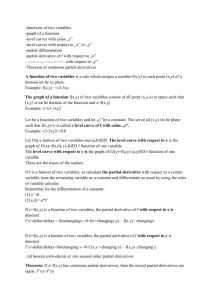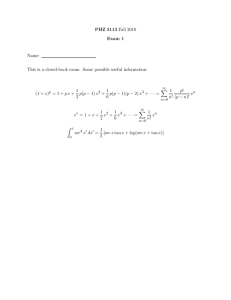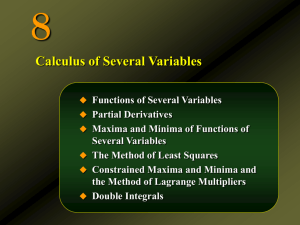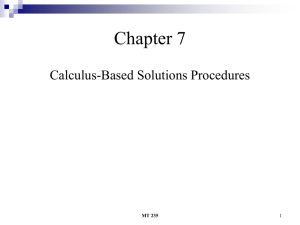SURVEY OF CALCULUS - NWACC
advertisement
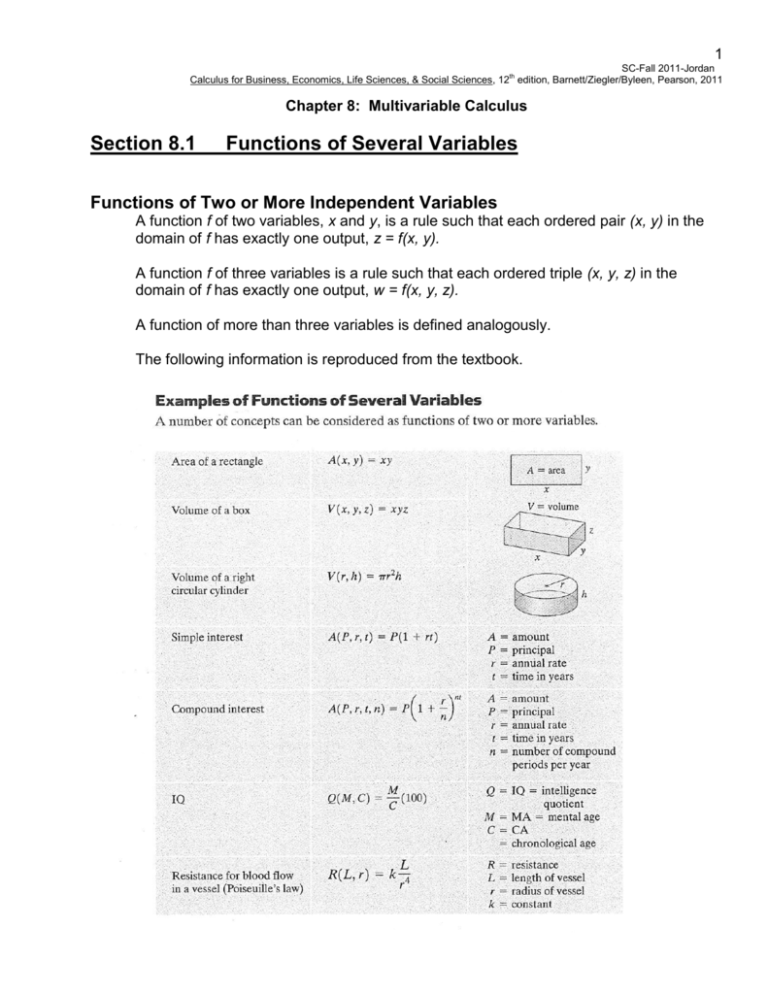
1 SC-Fall 2011-Jordan Calculus for Business, Economics, Life Sciences, & Social Sciences, 12th edition, Barnett/Ziegler/Byleen, Pearson, 2011 Chapter 8: Multivariable Calculus Section 8.1 Functions of Several Variables Functions of Two or More Independent Variables A function f of two variables, x and y, is a rule such that each ordered pair (x, y) in the domain of f has exactly one output, z = f(x, y). A function f of three variables is a rule such that each ordered triple (x, y, z) in the domain of f has exactly one output, w = f(x, y, z). A function of more than three variables is defined analogously. The following information is reproduced from the textbook. 2 Evaluating Functions of More than One Variable Plug in the given values in the appropriate locations and perform the arithmetic. Example 1 If ( ) ( ) , find A(10, 0.04, 3, 2). Three-Dimensional Coordinate System A three-dimensional coordinate system is formed by three axes that are mutually perpendicular and that intersect at their origins. A unique point in such a system can be represented by an ordered triple, (x, y, z). Example 2 Find the coordinates of the points E and C in the figure below. 3 Examples of Graphs of Functions of Two Independent Variables 4 5 Section 8.2 Partial Derivatives Partial Derivatives Functions of several variables have several derivatives, one for each variable. Each of these derivatives is called a partial derivative. The formal definitions of partial derivatives are similar to the definition of the derivative covered in chapter 3. Informal Definitions of Partial Derivatives The partial derivative of f(x, y) with respect to x is obtained by taking the derivative, treating x as the variable and y as a constant. This derivative is denoted f x (x, y) or The partial derivative of f(x, y) with respect to y is obtained by taking the derivative, treating y as the variable and x as a constant. This derivative is denoted f y (x, y) or For functions with more than two variables, partials are calculated by taking the derivative with respect to the chosen variable and treating all other variables as constants. Example 1 f(x, y) = 2x4 – 7x3y2 – xy + 1 a) Find fx(x, y) b) Find fy(x, y) Example 2 z = x2ey – (2x – 3y)8 a) Find b) Find Evaluating a Partial Derivative Differentiate first and then plug the numbers in to evaluate. Example 3 S(x, y) = x3 ln y + 4y2 ex a) Find Sx(-1, 1) b) Find Sy(-1, 1) f . x f . y 6 Second-Order Partial Derivatives There are four second-order partials for a function of two variables. fxx (x, y): Find fx , then differentiate that result with respect to x. Hold y constant each time. fyy (x, y): Find fy , then differentiate that result with respect to y. Hold x constant each time. fxy (x, y): Find fx , holding y constant. Then differentiate that result with respect to y, holding x constant. fyx (x, y): Find fy , holding x constant. Then differentiate that result with respect to x, holding y constant. Notice that the partial derivative of the variable closest to f is taken first. Higher-order partial derivatives are calculated in a similar manner. Example 4 f(x, y) = 4x2 – 3x3y2 +5y5 a) fxx b) fxy c) fyx d) fyy Interpreting Partial Derivatives in Applications Partial derivatives give the instantaneous rate of change of the function with respect to one variable at a time. The function will increase or decrease while one variable is held constant and the other variable is increased by one unit. Example 5 The length in feet of the tire marks from a truck of weight w (tons) traveling at velocity v (miles per hour) skidding to a stop on a dry road is S(w, v) = 0.027wv2. a) Find Sw(4, 60) and interpret this number. b) Find Sv(4, 60) and interpret this number. 7 Section 8.3 Maxima and Minima Critical Points of Functions of Several Variables A point (a, b) is a critical point of the function f(x, y) if both of its partial derivatives, f x and fy, equal zero at that point. To find the critical points Find fx and fy and set both equal to zero. Solve the resulting system of equations. Local maximum and minimum values can only occur at critical points, but not every critical point is a local extremum. Second-Derivative Test for Local Extrema Find the critical point(s) for the function. (a, b) is a critical point. Find the second-order partial derivatives fxx, fxy, and fyy. Evaluate the second-order partial derivatives at the critical point(s). A = fxx (a, b) B = fxy (a, b) C = fyy (a, b) Evaluate AC – B2. Then, If AC – B2 > 0 and A < 0, then f(a, b) is a local maximum. If AC – B2 > 0 and A > 0, then f(a, b) is a local minimum. If AC – B2 < 0, then f(a, b) is a saddle point. If AC – B2 = 0, the test is inconclusive. Example 1 Find the local extrema of f(x, y) = 5xy – 2x2 – 3y2 + 5x – 7y + 10 Example 2 Find the local extrema of f(x, y) = x3 – y2 – 3x + 6y Example 3 In a laboratory test the combined antibiotic effect of x milligrams of medicine A and y milligrams of medicine B is given by the function f(x, y) = xy – 2x2 – y2 + 110x + 60y (for 0 ≤ x ≤ 55, 0 ≤ y ≤ 60). Find the amounts of the two medicines that maximize the antibiotic effect. 8 Section 8.4 Maxima and Minima Using Lagrange Multipliers Constrained Optimization The method discussed in this section will be used when we are trying to maximize or minimize a function with more than one variable and we have a constraint in our problem. The function f(x, y) that is to be maximized or minimized is called the objective function. The constraint g(x, y) needs to be written so that the right side equals zero. We will introduce a new variable λ (lambda) and form a new function F(x, y, λ). Method of Lagrange Multipliers Identify the objective function f(x, y) and the constraint g(x, y) = 0 Form the Lagrange function: F(x, y, λ) = f(x, y) + λ g(x, y) Find Fx, Fy, and Fλ and set each of them equal to zero. Solve Fx and Fy for λ. Set the two expressions for λ equal to each other and solve for either x or y. Substitute that expression into Fλ and solve the resulting equation. Back-substitute to solve for the other variable. This will give your critical point(s). Plug the critical point(s) back into the original f(x, y) to determine the maximum or minimum value. This method of Lagrange multipliers only finds the critical points; it does not tell whether a function is maximized, minimized, or neither at the critical points. The D-test from section 7.3 cannot be used on constrained problems, so we are making an assumption that the solution to the original problem exists and that it occurs at the critical point(s). Example 1 Use Lagrange multipliers to maximize the function f(x, y) = 12xy – 3y2 – x2 subject to the constraint x + y = 16. Example 2 Use Lagrange multipliers to minimize the function f(x, y) = 5x2 + 6y2 – xy subject to the constraint x + 2y = 24. Example 3 Three adjacent identical rectangular lots are to be fenced in using 12,000 feet of fence. What is the largest total area that can be so enclosed? 9 Meaning of Lagrange Multiplier, λ The absolute value of λ gives us the change in the objective function that would result from changing the constraint function by one unit. Refer back to example 3: y 3000 750 750 4 4 For each additional foot of fencing used, the area is increased by 750 square feet.



